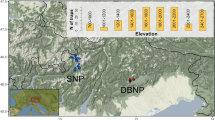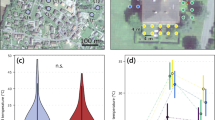Abstract
Patterns of ant species diversity are well documented and yet the mechanisms promoting species coexistence among communities are often elusive. Two emerging hypotheses that account for coexistence in ant communities are the discovery-dominance tradeoff and the dominance-thermal tolerance tradeoff. Here we used behavioural assays and community-level sampling from ant assemblages in the southern Appalachians, USA to test for the discovery-dominance and dominance-thermal tolerance tradeoffs. Species that were behaviorally dominant during interspecific interactions tended to forage in a narrow window of generally warmer temperatures, whereas subordinate species tended to forage in a wide range of temperatures, including colder temperatures. Species that foraged at lower temperature tended to be behaviourally subordinate, suggesting that a dominance-thermal tolerance tradeoff promotes coexistence in this system. Species richness was positively related to site average annual temperature and within-site variation in ground temperature, suggesting that temperature also shapes the structure of ant communities and regulates diversity. There was no relationship between the ability of a species to discover food resources and its behavioural dominance, contrary to the predictions of the discovery-dominance tradeoff hypothesis. In sum, our results show that temperature plays numerous roles in promoting regional coexistence in this system.




Similar content being viewed by others
References
Adler F.R., LeBrun E.G. and Feener Jr D.H. 2007. Maintaining diversity in an ant community: modelling, extending, and testing the discovery-dominance tradeoff. Am. Nat. 169: 323–333.
Albrecht M. and Gotelli N.J. 2001. Spatial and temporal niche partitioning in grassland ants. Oecologia 126: 134–141.
Andersen A.N. 1992. Regulation of momentary diversity by dominant species in exceptionally rich ant communities of the australian seasonal tropics. Am. Nat. 140: 401–420.
Andersen A. N. 2008. Not enough niches: non-equilibrial processes promoting species coexistence in diverse ant communities. Aust. Ecol. 33: 211–220.
Bernstein R.A. and Gobbel M. 1979. Partitioning of space in communities of ants. J. Anim. Ecol. 48: 931–942.
Bestelmeyer B.T. 1997. Stress tolerance in some Chacoan dolichoderine ants: Implications for community organization and distribution. J. Ar. Env. 35: 297–310.
Bestelmeyer B.T. 2000. The trade-off between thermal tolerance and behavioural dominance in a subtropical South American ant community. J. Anim. Ecol 69: 998–1009.
Cerdá X., Retana J. and Cros S. 1997. Thermal disruption of transitive hierarchies in Mediterranean ant communities. J Anim. Ecol. 66: 363–374.
Cerdá X., Retana J. and Cros S. 1998. Critical thermal limits in Mediterranean ant species: trade-off between mortality risk and foraging performance. Funct. Ecol. 12: 45–55.
Cerdá X., Retana J. and Manzaneda A. 1998a. The role of competition by dominants and temperature in the foraging of subordinate species in Mediterranean ant communities. Oecologia 117: 404–412.
Cros S., Cerdá X. and Retana J. 1997. Spatial and temporal variations in the activity patterns of Mediterranean ant communities. Ecoscience 4: 269–278.
Davidson D.W. 1977. Foraging ecology and community organization in desert seed-eating ants. Ecology 58: 725–737.
Davidson D.W. 1998. Resource discovery versus resource domination in ants: a functional mechanism for breaking the trade-off. Ecol. Ent. 23: 484–490.
Dunn R.R., Parker C.R. and Sanders N.J. 2007. Temporal patterns of diversity: Assessing the biotic and abiotic controls on ant assemblages. Biol. J. Linn. Soc. 91: 191–201.
Feener D. H., Orr M.R., Wackford K.M., Longo J.M., Benson W.W. and Gilbert L.E. 2008. Geographic variation in resource discovery-dominance in Brazilian ant communities. Ecology 89:1824–1836.
Fellers J.H. 1987. Interference and exploitation in a guild of woodland ants. Ecology 68: 1466–1478.
Fellers J.H. 1989. Daily and seasonal activity in woodland ants. Oecologia 78: 69–76.
Herbers J.M. 1989. Community structure in north temperate ants - temporal and spatial variation. Oecologia 81: 201–211.
Hölldobler B. and Wilson E.O. 1990. The Ants. Belknap, Cambridge, Mass. 732 pp.
Holway D.A. 1999. Competitive mechanisms underlying the displacement of native ants by the invasive Argentine ant. Ecology 80: 238–251.
Kaspari M., Ward P.S. and Yuan M. 2004. Energy gradients and the geographic distribution of local ant diversity. Oecologia 140: 407–413.
Knoepp J.D. and Swank W.T. 1998. Rates of nitrogen mineralization across an elevation and vegetation gradient in the southern Appalachians. Plant and Soil 204: 235–241.
LeBrun E. and Feener D. 2007. When trade-offs interact: balance of terror enforces dominance discovery trade-off in a local ant assemblage. J. Anim. Ecol. 76: 58–64.
O’Neill K.M. and Kemp W.P. 1990. Worker response to thermal constraints in the ant Formica obscuripes Hymenoptera, Formicidae. J. Therm. Biol. 15: 133–140.
Parr C.L., Sinclair B.J., Andersen A.N., Gaston K.J. and Chown S.L. 2005. Constraint and competition in assemblages: A cross-continental and modeling approach for ants. Am. Nat. 165: 481–494.
Perfecto I. 1994. Foraging behaviour as a determinant of asymmetric competitive interaction between 2 ant species in a tropical agroecosystem. Oecologia 98: 184–192.
Porter S.D. and Savignano D.A. 1990. Invasion of polygyne fire ants decimates native ants and disrupts arthropod community. Ecology 71: 2095–2106.
Sanders N.J. and Gordon D.M. 2003. Resource-dependent interactions and the organization of desert ant communities. Ecology 84: 1024–1031.
Sanders N.J., Gotelli N.J., Heller N.E. and Gordon D.M. 2003. Community disassembly by an invasive species. Proc. Natl. Acad. Sci. USA 100: 2474–2477.
Sanders N.J., Lessard J.P., Fitzpatrick M.C. and Dunn R.R. 2007. Temperature, but not productivity or geometry, predicts elevational diversity gradients in ants across spatial grains. Glob. Ecol. Biol. 16: 640–649.
Santini G., Tucci L., Ottonetti L. and Frizzi F. 2007. Competition trade-offs in the organisation of a Mediterranean ant assemblage. Ecol. Ent. 32: 319–326.
Savolainen R. and Vepsalainen K. 1988. A competition hierarchy among boreal ants - impact on resource partitioning and community structure. Oikos 51: 135–155.
Swank W.T. and Crossley D.A. 1988. Introduction and site description. In: Forest Hydrology and Ecology at Coweeta (W.T. Swank and D.A. Crossley, Eds). Springer-Verlag, New York, USA, pp. 3–16.
Swift L., Cunningham G. and Douglas J.E. 1988. Introduction and site description. In: Forest Hydrology and Ecology at Coweeta (W.T. Swank and D.A. Crossley, Eds). Springer-Verlag, New York, USA, pp. 35–55.
Vepsalainen K. and Pisarski B. 1982. Assembly of island ant communities. An. Zool. Fen. 19: 327–335.
Wilson E.O. 1971. The Insect Societies. Belknap Press, Cambridge, Mass. 548 pp.
Yanoviak S.P. and Kaspari M. 2000. Community structure and the habitat templet: ants in the tropical forest canopy and litter. Oikos 89: 259–266.
Acknowledgments
Thanks to Tara Sackett, Mariano Rodriguez Cabal and Greg Crutsinger for providing comments on the manuscript, and to Noa Davidai for editing the manuscript. Discussions with Ed Lebrun and Phil Wiescher contributed to improving the quality of the manuscript. JP Lessard was supported by a FQRNT and a NSERC scholarship. NJ Sanders and RR Dunn were supported by grants from DOE-NICCR and DOE-PER.
Author information
Authors and Affiliations
Corresponding author
Rights and permissions
About this article
Cite this article
Lessard, JP., Dunn, R.R. & Sanders, N.J. Temperature-mediated coexistence in temperate forest ant communities. Insect. Soc. 56, 149–156 (2009). https://doi.org/10.1007/s00040-009-0006-4
Received:
Revised:
Accepted:
Published:
Issue Date:
DOI: https://doi.org/10.1007/s00040-009-0006-4




